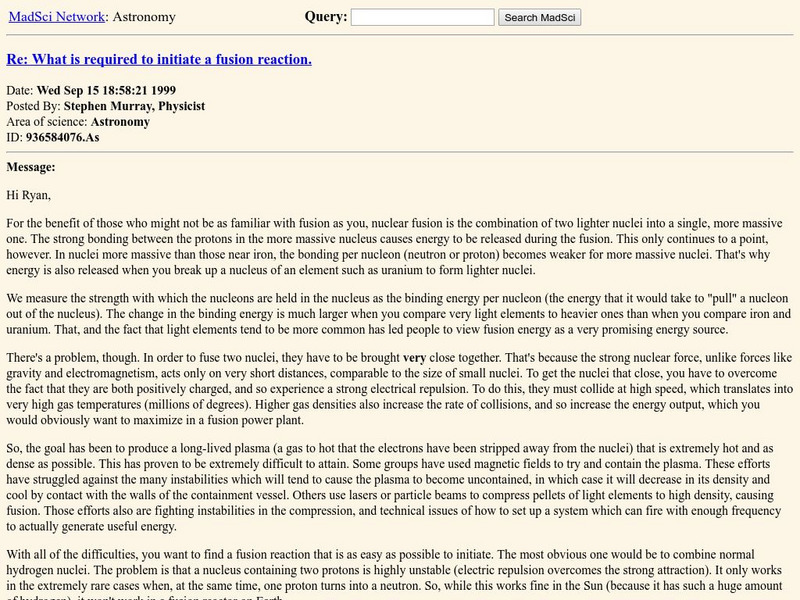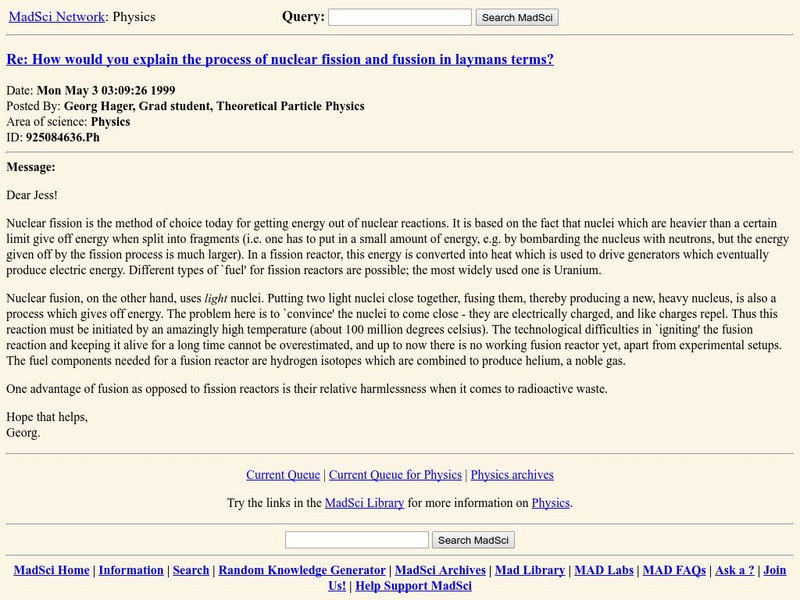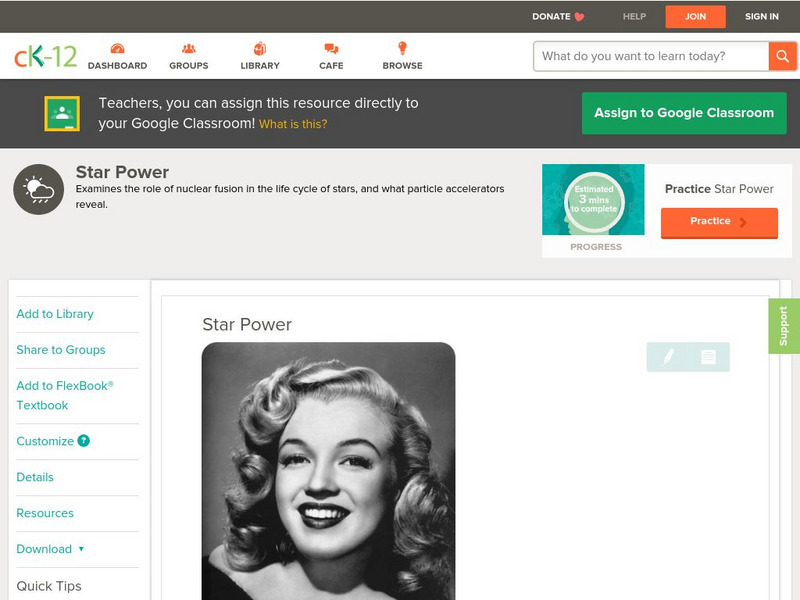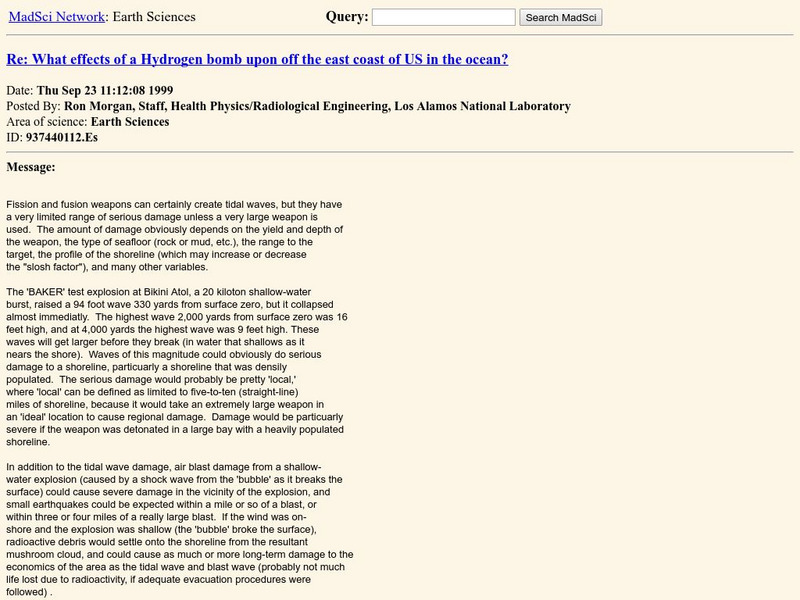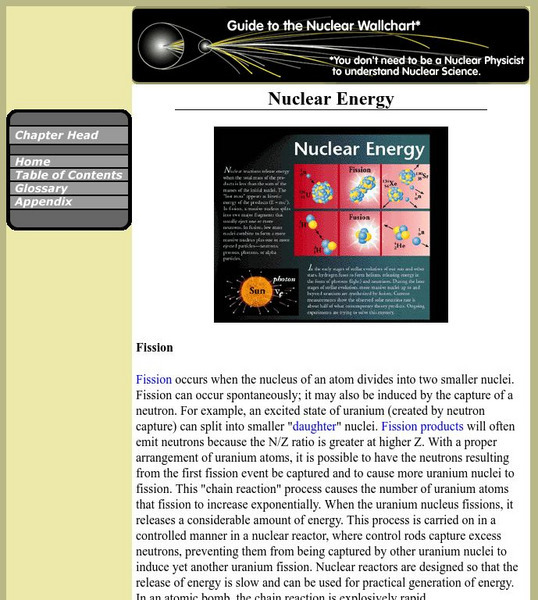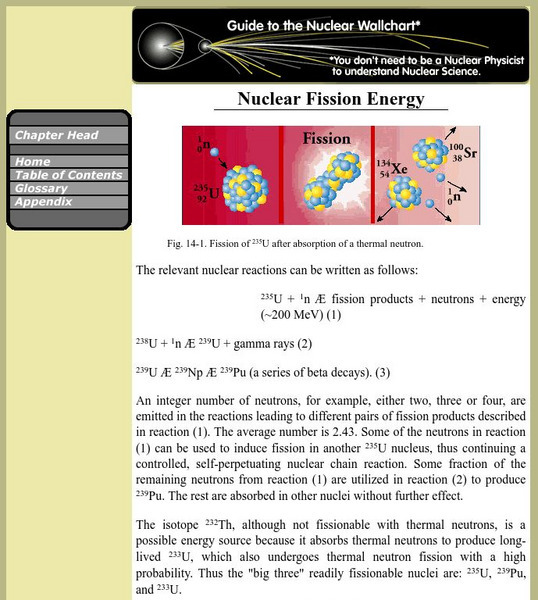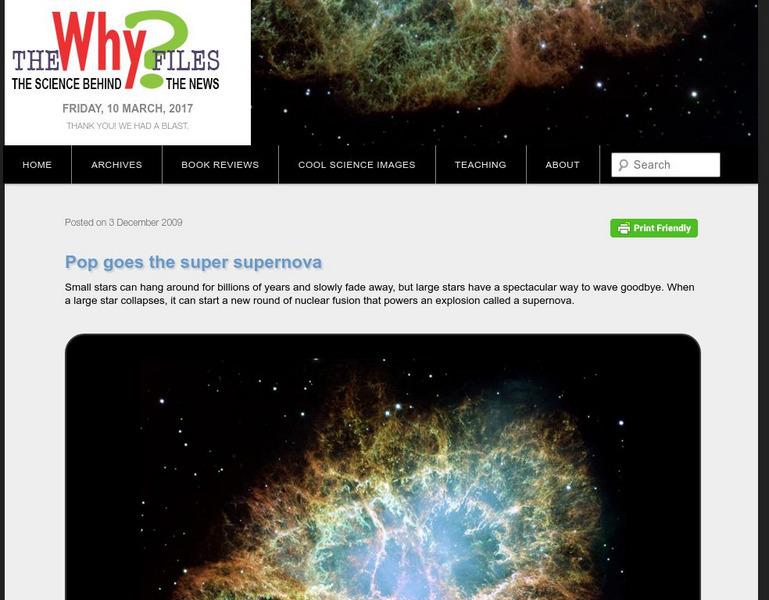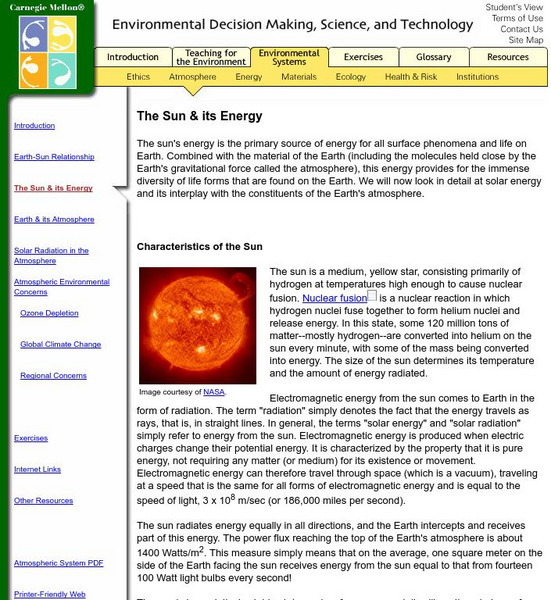CK-12 Foundation
Ck 12: Earth Science: Nuclear Power
[Free Registration/Login may be required to access all resource tools.] How energy can be generated through nuclear reactions.
MadSci Network
Msn: What Regulates the Speed of Hydrogen Fusion?
From the Mad Scientist Network web site. Using a question and answer format, this page describes the various types of fusion processes and the physical requirements needed for their initiation and sustenance. Factors affecting the rates...
MadSci Network
Msn: What Is Required to Initiate a Fusion Reaction?
From the Mad Scientist Network web site. Using a question and answer format, this page provides a thorough discussion of fusion reactions. Fusion and fission are compared and contrasted and the mechanisms which must occur to initiate and...
Encyclopedia of Earth
Encyclopedia of Earth: Solar Radiation
Almost all of the energy that drives the various systems (climate systems, ecosystems, hydrologic systems, etc.) found on the Earth originates from the sun. Solar energy is created at the core of the sun when hydrogen atoms are fused...
Georgia Department of Education
Ga Virtual Learning: Physical Science: Nuclear Chemistry
A complete learning module with interactive activities as well as informational text to help students distinguish the characteristics and components of radioactivity.
Curated OER
Nuclear Fusion
From the Atomic Archive - the online companion to the award-winning CD-ROM. This page defines nuclear fusion and depicts the process by an informative diagram. Includes numerical values which describe the typical energy values for fusion...
MadSci Network
Msn: How Would You Explain the Process?
From the Mad Scientist Network web site. Using a question and answer format, this page explains the differences between nuclear fusion and nuclear fission. The details of each process are sketched in simple language.
CK-12 Foundation
Ck 12: Earth Science: Star Power
[Free Registration/Login may be required to access all resource tools.] Examines nuclear fusion in stars and simulated in particle accelerators.
CK-12 Foundation
Ck 12: Earth Science: Star Power
[Free Registration/Login may be required to access all resource tools.] Examines nuclear fusion in stars and simulated in particle accelerators.
NASA
Nasa: Space Place: Play Helios: A Game About How the Sun Makes Energy!
In this pairing game, keep the Sun shining bright by matching up particles. Convert hydrogen atoms into helium atoms. This process is called nuclear fusion.
Curated OER
Nuclear Fusion Movie
From the Atomic Archive - the online companion to the award-winning CD-ROM. This page defines nuclear fusion and depicts the process by an informative diagram. Includes numerical values which describe the typical energy values for fusion...
MadSci Network
Msn: What Are the Effects of a Hydrogen Bomb?
From the Mad Scientist Network web site. Using a question and answer format, this page describes some potential effects of a nuclear explosion. The possibilities of tidal waves, earthquakes and radiation-related damages are discussed.
Ducksters
Ducksters: Physics for Kids: Nuclear Energy and Fission
Kids learn about nuclear energy and fission in the science of physics including E=mc2, power plants, uses of nuclear power, and fusion.
Lawrence Berkeley National Laboratory
Berkeley Lab: Nuclear Energy: Fission/fusion
Provides a definition and explanation of fission, the splitting of a heavy nucleus into two roughly equal parts, and fusion, the process where two nuclei combine together to form a larger nucleus.
Lawrence Berkeley National Laboratory
Berkeley Lab: Basic Nuclear Science Information
Site provides the ABC's of nuclear science including radioactivity and gamma decay to fission and comic rays.
Nobel Media AB
The Nobel Prize: Energy From Matter
The history of energy being transformed from matter is provided at this site. The information starts at Einstein's formula, then discussions fusion, future energy sources, fission, and nuclear reactors.
Lawrence Berkeley National Laboratory
Berkeley Lab: Nuclear Fission Energy
Resource explains and illustrates nuclear fission energy.
Lawrence Berkeley National Laboratory
Berkeley Lab: Nuclear Reactions
Site investigates nuclear reactions with a description of how they occur.
BBC
Bbc: Gcse Bitesize: The Life Cycle of a Star
This lesson focuses on the formation and life cycle of stars. Stars form when enough dust and gas clump together because of gravitational forces. Nuclear reactions release energy to keep the star hot. Some stars grow larger over time....
University of Wisconsin
The Why Files: Pop Goes the Super Supernova
Small stars can hang around for billions of years and slowly fade away, but large stars have a spectacular way to wave goodbye. When a large star collapses, it can start a new round of nuclear fusion that powers an explosion called a...
Stanford University
Stanford Report: Edward Teller, Father of Hydrogen Bomb
Students don't generally learn much about Edward Teller in school. But with the progress in science in the 20th century, maybe they should. Edward Teller was one of the main architects of the hydrogen bomb. This is a great site by...
Carnegie Mellon University
Telstar: The Sun and Its Energy
The sun's energy is the primary source of energy for all surface phenomena and life on Earth. Combined with the material of the Earth (including the molecules held close by the Earth's gravitational force called the atmosphere), this...
NASA
Nasa: Exploring Climate Change
Test your knowledge of energy and its role in Earth's climate system with these interactive quizzes.
NASA
Nasa: Imagine the Universe: Supernovae Remnants
A brief description of supernova remnants with many embedded links to help define terms used in the description. The specific topics are age and the importance of remnants to us and the types. Definitions of key words are provided.
Other popular searches
- Sun Nuclear Fusion
- Nuclear Fusion and Fission
- Stars Nuclear Fusion
- Nuclear Fusion in Stars
- Nuclear Fusion Lab
- Earth Science Nuclear Fusion
- Nuclear Fusion Within Star
- Physics of Nuclear Fusion
- Nuclear Fusion and Fision




